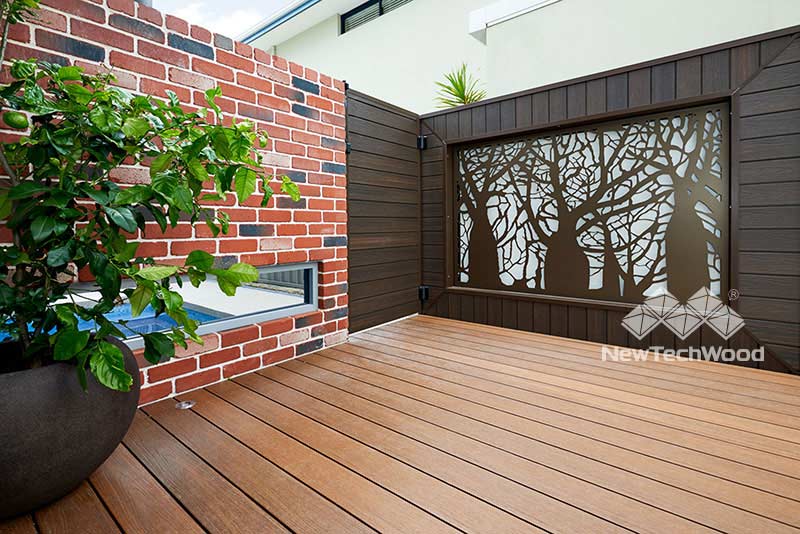
Para melhorar a estética e a funcionalidade do seu quintal, considere a instalação de um novo deck ou pátio fora de casa. Os materiais de deck de madeira composta são uma alternativa durável e de baixa manutenção à madeira maciça. Por outro lado, os pavimentos de pátio vêm em vários materiais que podem complementar o seu design exterior. Ao pensar em como decorar sua propriedade ao ar livre, você provavelmente precisará pesar os prós e contras enquanto se pergunta: “Um deck ou pátio é certo para mim?”
Considere os requisitos de custo, apelo visual e cuidados de cada tipo de plataforma antes de tomar sua decisão. Também é necessário pensar no terreno que rodeia o seu imóvel e como gostaria de utilizar a sua área de estar exterior. Este guia irá ajudá-lo a descobrir se você deve colocar em um deck ou pátio.
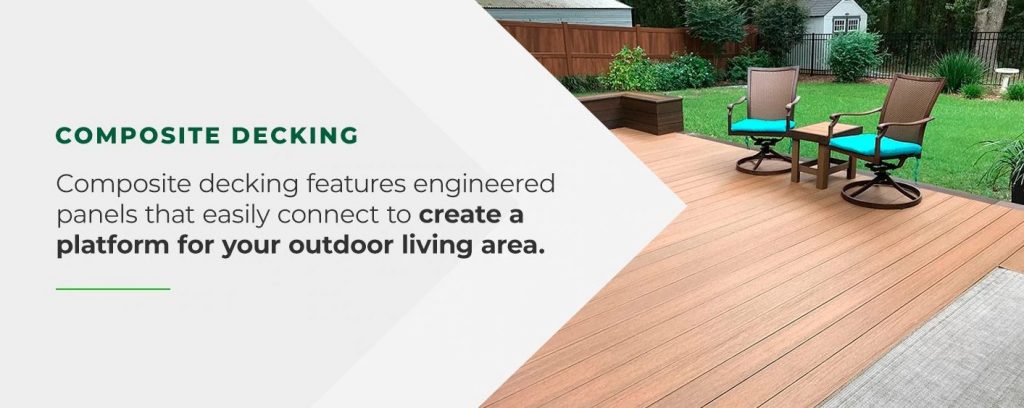
O QUE É DECK COMPOSTO?
O deck composto apresenta painéis projetados que se conectam facilmente para criar uma plataforma para sua área de estar ao ar livre. Este material sintético contém madeira de papel, serragem e resíduos moídos, bem como plástico reciclado de sacos de compras, garrafas de água e jarros. Juntas, essas fibras produzem um deck esteticamente agradável, de baixa manutenção e ecologicamente correto, incluindo o corrimão, corrimão e escadas.
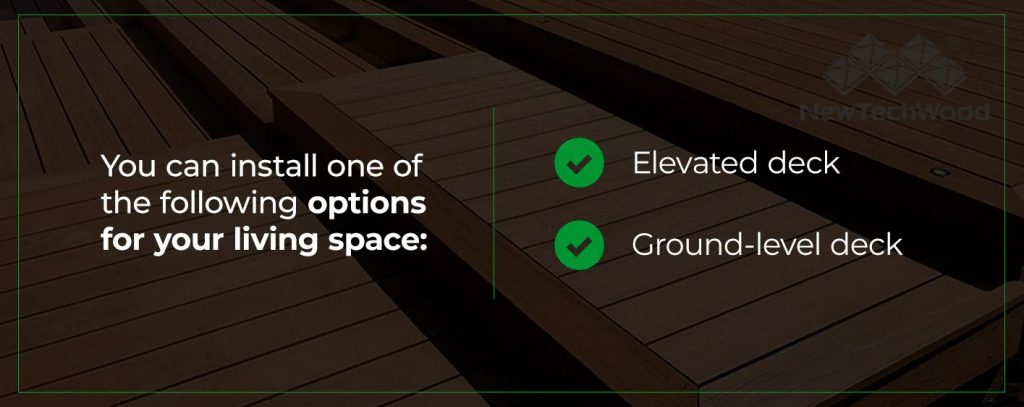
Os decks são plataformas elevadas, muitas vezes anexadas à casa, que fornecem um lugar para entretenimento ao ar livre. Pode instalar uma das seguintes opções para o seu espaço:
- Deck elevado: Com esta configuração, o instalador eleva a plataforma a vários metros do chão, normalmente estendendo-se da sala de jantar ou sala de estar fora do nível principal da casa. Esta configuração pode acomodar lotes inclinados e terrenos irregulares, proporcionando um espaço de entretenimento perfeito para áreas montanhosas ou propriedades elevadas. Um deck elevado também possui escadas que você pode incorporar ao seu design exterior.
- Deck no nível do solo: Como alternativa a um deck elevado, uma plataforma no nível do solo é quase nivelada com o solo e não requer o uso de escadas. Apesar do nome, o deck fica a poucos centímetros do chão com vigas que o apoiam sobre uma subestrutura ligeiramente elevada. Esta subestrutura dá-lhe estabilidade, para que não tenha de ligar a plataforma à casa.
Os painéis compostos são uma alternativa à madeira maciça e à madeira tratada sob pressão. Os fabricantes adicionam pigmentos à mistura durante a produção para criar uma grande variedade de tons naturais à sua escolha. Estas cores podem complementar a sua estética de design exterior, quer a sua casa seja tradicional ou moderna. Os inibidores ultravioleta (UV) dentro da madeira composta impedem ou diminuem a taxa de desbotamento do sol, mantendo sua aparência natural de madeira em qualquer condição climática.
Os painéis de deck compostos vêm em várias opções de camada protetora que melhoram sua durabilidade, incluindo:
- Sem tampa: O material de deck composto original não tinha uma camada protetora externa, deixando seu núcleo exposto. Como resultado, a humidade e os raios UV podem infiltrar-se na prancha e arruinar a sua integridade. Após exposição excessiva, pode riscar, desmoronar ou desbotar dos elementos, exigindo uma substituição.
- Camada coberta com pó de madeira: Esta opção composta apresenta uma tampa com uma camada externa de pó de madeira, tornando o material vulnerável a condições climáticas adversas. Os painéis artificiais que usam pó de madeira em sua camada tampada sofrem os mesmos danos como se não tivessem tampas.
- Tampado a meio: Outra possibilidade é fabricar deck composto com proteção apenas na sua metade superior. Esta prancha tem uma maior resistência a danos UV, manchas e riscos do que materiais não tampados, mas a falta de tampamento por baixo deixa a metade inferior suscetível à umidade. À medida que a água entra pelo fundo, as tábuas torcem e copos, rachando as camadas superiores e até rasgando o núcleo.
- Totalmente tampado com ranhura roteada: Com esta configuração, o fabricante corta as ranhuras depois de aplicar uma tampa nas placas. Como resultado, a água e outras intempéries podem infiltrar-se no núcleo através das lacunas na proteção, fazendo com que os painéis se deformem ou cedam.
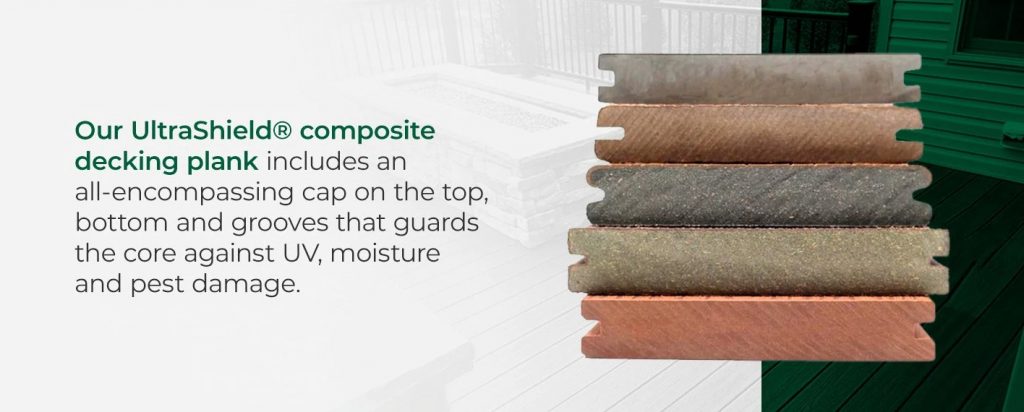
- Tampado 360 graus: Nosso A prancha de deck composta UltraShield® inclui uma tampa abrangente na parte superior, inferior e sulcos que protege o núcleo contra danos causados por UV, umidade e pragas. Como o material de deck da mais alta qualidade, ele durará várias décadas em sua propriedade ao ar livre, fornecendo a proteção mais excecional contra os elementos.
A NewTechWood fornece uma tampa de 360 graus em todos os nossos materiais de deck, estendendo sua vida útil e protegendo-os contra as intempéries. Incluímos os seguintes componentes nas nossas tábuas de madeira composta:
- Núcleo composto: O centro de nossas placas de deck compósitas contém fibras densas e recicladas de madeira dura e macias para melhorar sua resistência e qualidade.
- CTampa o-extrudida: Junto com o núcleo, colocamos uma camada protetora abrangente em cima dele para proteger cada lado da prancha de danos. Colocamos a prancha e a tampa sob um molde quente durante o processo de fabricação, permitindo-nos fornecer uma blindagem adequada sem o uso de adesivos ou produtos químicos nocivos. Como resultado, nossas tábuas são ecológicas e seguras para uso em seu espaço ao ar livre.
Painéis de madeira composta de alta qualidade conectam-se à casa ou fáscia com clipes de deck para uma instalação conveniente e sem estresse. Os fixadores e finalizadores do convés completam o processo de instalação, fornecendo uma borda protetora suave para as tábuas.
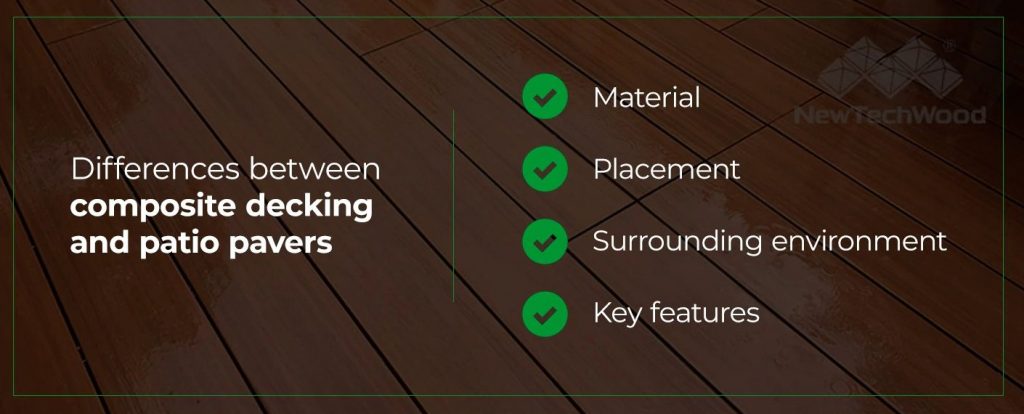
PAVER PÁTIOS VS. DECKS COMPOSTOS
Além de um deck composto, um pátio de paver também é um design popular para sua área de estar ao ar livre. As principais diferenças entre decks e pátios incluem sua configuração, localização e materiais de construção. Embora ambas as opções ofereçam um melhor valor para sua área de estar ao ar livre, é útil considerar os vários fatores, como comparar madeira composta com concreto ou tijolo e ter uma plataforma elevada ou no nível do solo.
Ao conhecer as características de cada tipo de superfície, você pode entender melhor o que melhoraria o valor do seu imóvel. Além de preço, localização e terreno, a sua escolha também se resume à preferência pessoal. Considere as diferenças fundamentais entre decks compostos e pavimentos de pátio para ver como cada opção pode beneficiar sua casa:
- Materiais: O deck composto contém madeira reciclada e fibras de plástico para produzir uma prancha esteticamente agradável e de baixa manutenção. Eles podem complementar qualquer estilo de design por causa de sua aparência única. Os pátios de pavimentação geralmente apresentam blocos feitos de concreto ou tijolo.
- Placement: A patio is an outdoor entertainment area that sits against the ground to give you a private place to enjoy the backyard. When installing your patio or deck, find out if the yard is level. Patios need a flat surface to extend their lifespan, so you’ll need to shore up the ground to make it level. On the other hand, you can build composite decking on top of a support system that keeps them slightly elevated, so they don’t need an even terrain.
- Surrounding environment: Examine your property and consider which aesthetic elements you’d like to highlight. With a patio, surrounding shrubbery and flowers become focal points of the area. Elevated decks provide a breathtaking view of your yard and beyond.
- Key features: As you design your outdoor living space, think about what’s missing. With a patio, you can add a fire pit, birdbath or foundation. You can even install a grill to create an outdoor kitchen in the appropriate weather conditions. Since a deck is high above the ground, it needs a boundary around the perimeter, like a guardrail or fence. You can also decorate the stairs and set up a built-in bench on your composite wooden platform.
ADVANTAGES OF COMPOSITE DECKING
Synthetic wood deck materials will enhance your yard’s aesthetic appeal. No matter what your home’s climate is like, a composite deck can accommodate extreme temperatures and last for several decades with the proper maintenance. Consider some of the benefits of installing composite decking to determine if it’s the right option for your outdoor living space.
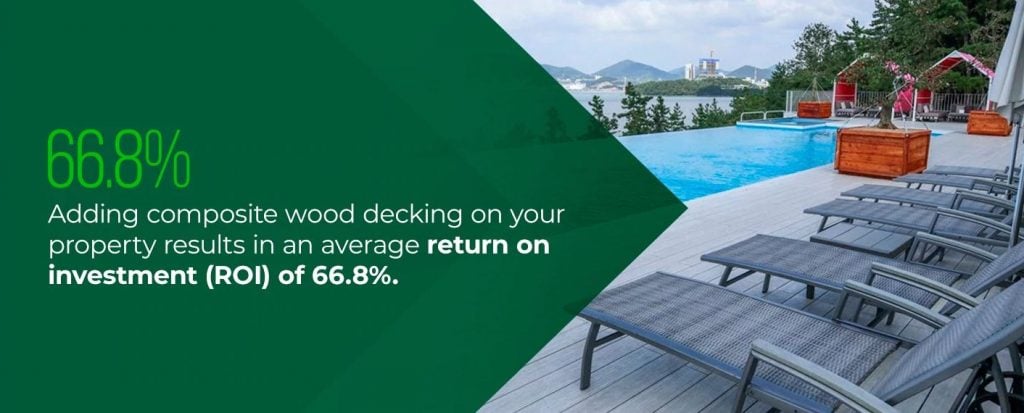
1. It Yields a Higher Resale Value
Adding composite wood decking on your property results in an average return on investment (ROI) of 66.8%. You’ll save money on your composite wood deck in the following ways:
- Installation: Since composite wood decking materials are easy to install yourself, it’s unnecessary to hire a contractor to help you. Doing it yourself eliminates the installation cost that you would have to pay a professional. For additional support on laying down your new deck, we offer a composite deck installation guide to walk you through the process.
- Maintenance: Solid hardwood and other materials require annual staining and sealing to maintain their appearance and durability. For taking care of composite wood decking, all you need to do is clean it with warm, soapy water and a soft-bristled brush. It also helps to remove debris and clean up spills immediately.
- Replacement: Composite wood decking materials can last for several decades, but if a panel loses its quality earlier than that, you can replace it instead of installing a brand-new deck. The simplicity of replacing one panel can save you money to replace your broken components.
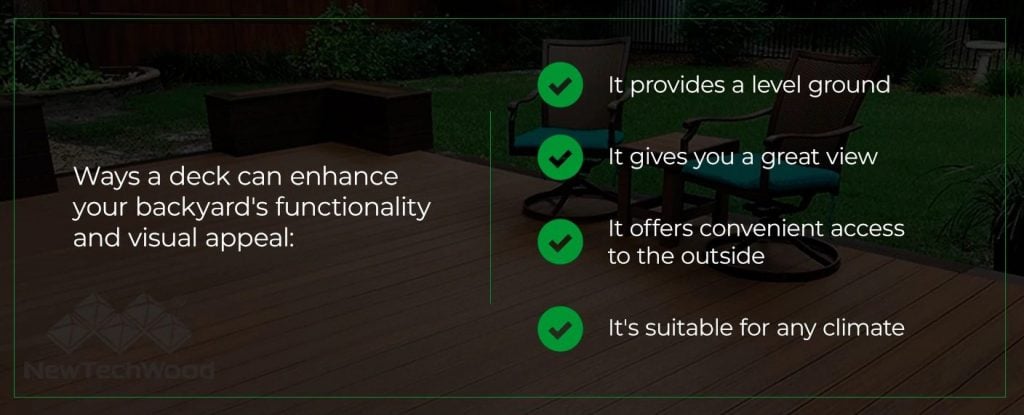
2. It Can Accommodate Your Property
A composite wood deck can be more efficient on your property than a patio. Here are some of the ways a deck can enhance your backyard’s functionality and visual appeal:
- It provides a level ground: Even if your yard isn’t level, you can install a deck to provide a safe place for gathering outdoors. Raised decks can help accommodate the area around a sloping or uneven ground.
- It gives you a great view: If you build your deck high off the ground, you can get a better chance to see the natural beauty around your property. This renovation increases your home’s value because potential homeowners enjoy the opportunity to check out the breathtaking scenery.
- It offers convenient access to the outside: The boards tend to be longer than wood, so they can take up more space to accommodate your needs. With longer boards, you don’t need to install as many end joints. Since a deck attaches to your home, it provides easy access from one room to the outside.
- It’s suitable for any climate: NewTechWood composite wood decking can withstand any location’s weather conditions. If you live in an area that experiences high temperatures, the panels won’t warp or buckle, and they tend to retain less heat than natural wood. This material is also efficient in cold climates because it doesn’t expand or contract. You can easily clean the snow and ice off your deck with a plastic shovel and ice melt.
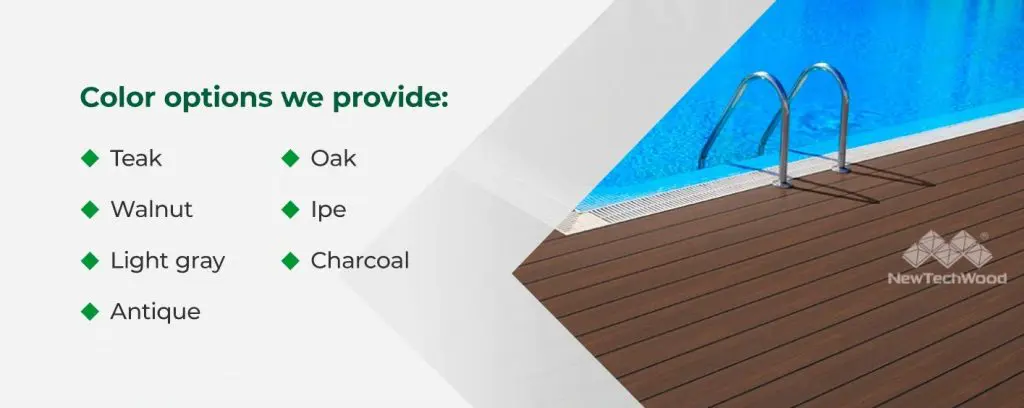
3. It’s Versatile in Design
Composite wood decking materials come in many colors to complement your design style. At NewTechWood, we can make your materials any custom color you send us, including our natural wood tones. Consider matching the exterior siding of your house or the colors of the landscaping throughout your property.
Here are the color options we provide:
- Teak: This stain finish reflects the durable and elegant teak wood species to give a high-quality outdoor composite deck that looks like natural wood.
- Walnut: Featuring a rich, dark wood finish, our walnut color provides an attractive visual appeal for your backyard deck.
- Light gray: This contemporary, robust composite wood finish can enhance your modern home’s design aesthetic.
- Antique: Consider antique composite decking that provides a rustic appearance for a vintage deck.
- Oak: This classic wood species symbolizes strength and longevity, so it naturally complements your durable composite wood decking.
- Ipe: This wood species is one of the most coveted decking materials, providing you with a high-quality composite platform.
- Charcoal: For a one-of-a-kind composite wood deck, consider smoky, dark charcoal panels to complement your contemporary home design.
Teak, walnut, light gray and antique composite wood deck panels are available with thin channel grooves to provide a streamlined appearance. You can also design your outdoor living space with various accessories, such as benches, railings and planters.
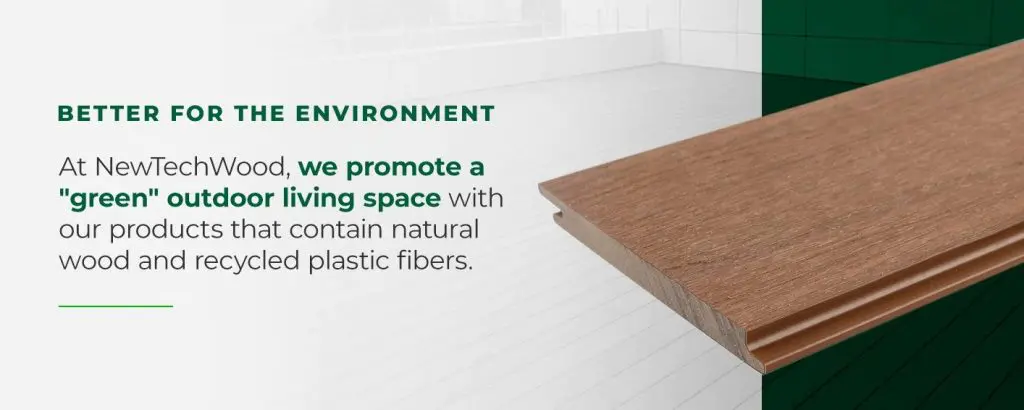
4. It’s Better for the Environment
At NewTechWood, we promote a “green” outdoor living space with our products that contain natural wood and recycled plastic fibers. When you invest in our composite decking materials, you know you’re investing in a company that believes in developing a healthier, safer world. As a foundation, we have these principles holding us accountable to maintain our eco-friendly practices:
- We strive to reduce our carbon footprint during the manufacturing process by limiting waste, saving energy and optimizing our eco-friendly strategies.
- Each year, we go through third-party auditing to preserve our compliance with safety, environmental and health regulations.
- Our products contain 95% recycled materials, including reclaimed wood fibers and plastic bottles.
By investing in green composite wood decking materials, you promote the creation of a healthier environment, society and economy.
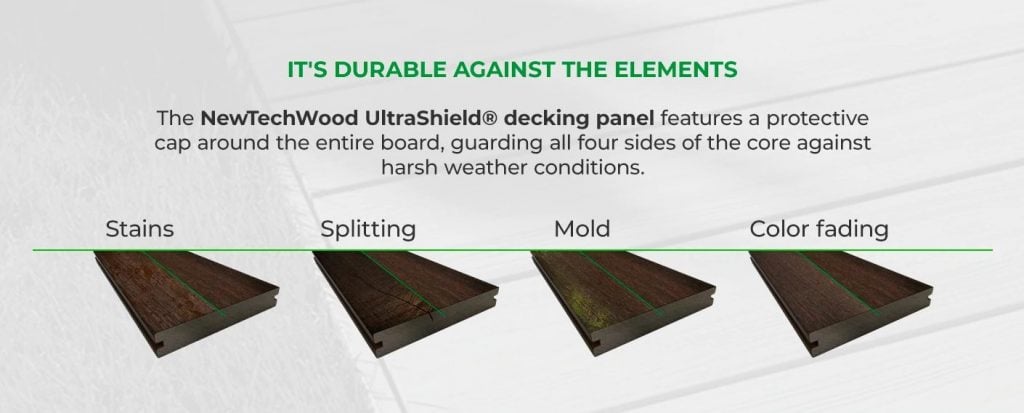
5. It’s Durable Against the Elements
Composite wood is pre-treated to withstand the elements of your local climate, so you don’t have to treat it every year like you’d have to do with natural wood. The NewTechWood UltraShield® decking panel features a protective cap around the entire board, guarding all four sides of the core against harsh weather conditions. The co-extruded cap and the synthetic center can withstand:
- Stains: Composite wood decking is resistant to stains from food and beverages so you can have peace of mind during your outdoor summer parties. Even though you should wipe up spills as soon as you notice them, these boards have a better chance of withstanding wine and coffee than other materials.
- Splitting: Our composite wood decking lasts longer than uncapped panels because of the protective shield that guards them against moisture and UV damage. As a result, the surface of our product won’t split after excessive exposure to the elements.
- Mold: Natural wood can develop mold and mildew when it comes into contact with excess moisture. The protective layer over our boards prevents fungal growth from deteriorating the material. Even though mold could emerge when standing water is present, you can easily clean it with a broom and hose because the mold is growing on the water, not the board.
- Color fading: The components of the cap preserves the color of our composite wood decking boards. When you first install the panels, keep in mind that the color may fade to adapt to direct sunlight, but then the fading stops. As a result, its appearance is much more resistant to discoloration than other materials, so you won’t have to paint or oil your boards ever again.
This durability makes composite decking easy to maintain, so it’ll last a long time in your outdoor living area. Since you won’t have to replace it as often, you’ll save money on installation costs in the future.
DISADVANTAGES OF COMPOSITE DECKING
Along with the benefits, it also helps to consider the drawbacks of a composite wood deck to make an informed decision. These disadvantages depend on the quality of the installation and local regulations for establishing decking on your property.
1. It Requires More Maintenance Than a Patio
Composite wood decking materials have been pre-treated with a co-extruded cap to enhance their resistance to the weather elements. Since it already comes with a pre-treatment, you don’t have to treat it each year like you would with a natural wood deck. However, keep in mind that you still need to maintain them to extend your deck’s lifespan.
Standing water can produce mold around the boards, so you’ll have to remove any moisture from them after a heavy rainstorm. You can regularly maintain your composite wood deck by powerwashing it and scrubbing out stains with warm, soapy water. It also helps to remove dirt, leaves and other debris with a broom at least once a week.
2. It May Have a Shorter Lifespan Than a Patio
Synthetic wood can last much longer than natural wood because of its resistance to rotting and warping. However, if you don’t maintain your composite deck by getting rid of standing water and cleaning the debris off of the panels, it may not last as long as a concrete or brick paver patio can.
A concrete patio can last several decades, but a composite wood deck has the potential to last just as long. It’s essential to take care of your decking according to its usage and your home’s local weather conditions to preserve its quality.
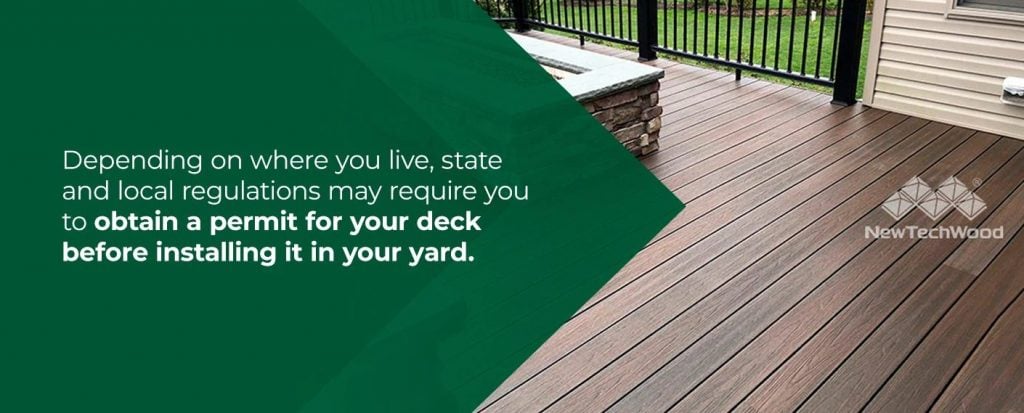
3. You May Need a Permit to Install a Deck on Your Property
Depending on where you live, state and local regulations may require you to obtain a permit for your deck before installing it in your yard. This specification may delay your installation process by a few weeks, and you may have to pay an additional fee. Before beginning your composite wood decking project, it may help to review your area’s guidelines so you don’t have to remove your new deck if it’s not up to code.
4. It Tends to Be More Expensive Than Some Patio Paver Materials
High-end composite wood decking may cost more than low-quality materials, such as concrete. The overall cost of your deck depends on the size of the area you’d like to cover. It also helps to consider the resale value of a deck vs. patio and the benefits your new platform will provide for your living space.
When weighing the costs of installing a patio, keep in mind that it needs to be on level ground, so you’ll have to pay to make the surface even if you choose to install it on your property.
5. It Has Weight Restrictions That May Limit Your Design
Since it doesn’t have the ground as a foundation underneath it, a deck tends to have a lower tolerance for heavy weight than a patio. This restriction affects your ability to install an outdoor kitchen or a hot tub, but you can set up outdoor benches and other decorative furniture. You may consult the manufacturer’s instructions for what weight is appropriate for your composite wood deck.
6. It Isn’t Completely Resistant to Wear and Tear
Even though composite wood lasts longer than natural solid hardwood, especially with the UltraShield® co-extruded cap, it can suffer from wear and tear when you don’t maintain it properly. This material can develop scratches if you drag furniture along it, or your pet digs their nails or claws into the panels.
Besides scratches, dark colors tend to absorb heat more quickly, so it might be uncomfortable for people walking with bare feet. You also have to make sure that you evenly space out the supporting joists according to the manufacturer’s instructions. Otherwise, the boards may sag and lose their integrity.
ADVANTAGES OF PATIO PAVERS
As a possible alternative to installing composite wood decking as an outdoor living area, consider the benefits of patio pavers for your property:
- They can accommodate most budgets: Some patio paver materials tend to cost less money upfront than composite wood decking panels. A concrete patio can be less expensive than other high-end options. Since you install a patio flush with the ground, you don’t need as many materials and labor for stairs, joists, railings and other deck components. As a result, you could save money during the installation process.
- They can be easier to install: Patios are more versatile than decks, so you can install them based on your design and function preferences. You don’t have to attach your paver platform to the house, but doing so provides easy access to your backyard. Since they have such a convenient installation process, you may be able to do it yourself and save even more money.
- They offer a private outdoor living area: Since it’s lower to the ground, a patio gives you the privacy you desire to enjoy your property while keeping away nosy neighbors. You can also enclose your patio with a screen so others can’t see into your yard. Since you may have more space to entertain, you can add furniture, a grill or fire pit to accommodate your outdoor summer parties.
- Some materials can last a long time without much maintenance: Concrete patio pavers can last for several decades when they’re clean and moisture-free. Homeowners with patios should clean theirs frequently to get rid of leaves and other debris so they can have an aesthetically pleasing place to enjoy the outdoors. Concrete pavers are durable and long-lasting, but sealing a concrete paver patio can help it last longer.
- You may be able to install them without a permit: You don’t usually need approval or an inspection to install a patio, but you may want to consult local and state regulations for the necessary paperwork and steps.
- Certain patio materials are durable: Since pavers are hard, they’re less likely to break, and they probably won’t lose their color or luster over time. Even if part of the material cracks, you can conveniently replace one paver instead of installing a brand-new deck. Patio pavers are more resistant to cracking than concrete pads because of their flexible integrity, allowing them to accommodate the earth’s movement underneath them.
- They slightly increase your home’s resale value: Even if a composite wood deck has the potential to increase your property value more significantly, a patio still adds quality and functionality to your backyard. With a paver patio, you have another place to entertain guests and enjoy the pleasant weather.
- Brick patio pavers contain eco-friendly materials: These blocks contain natural clay material that comes directly from the earth’s soil, so it doesn’t negatively affect the environment. It’s also possible to recycle and re-use them to reduce waste from production.
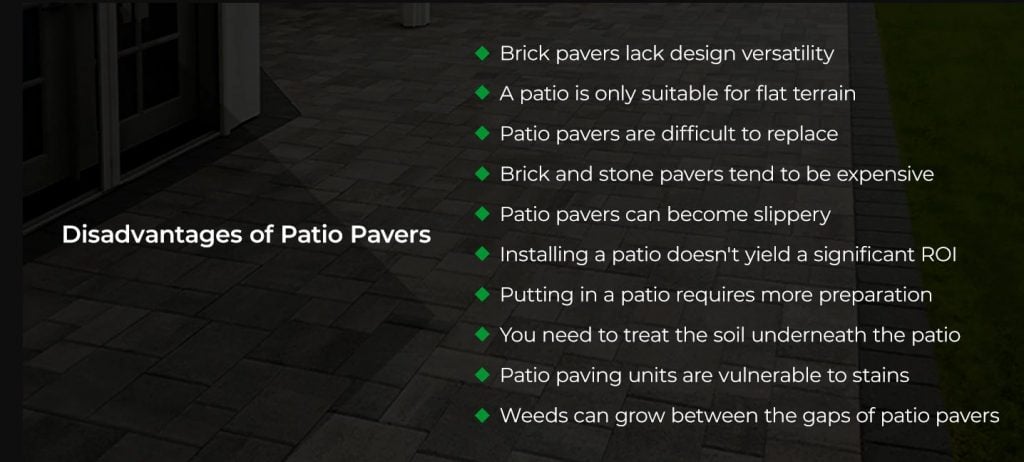
DISADVANTAGES OF PATIO PAVERS
After reviewing the benefits of patio pavers, take time to note the drawbacks of installing a patio so you may consider whether composite decking is the better option:
- Brick pavers lack design versatility: Brick pavers are available in a few different textures and colors, but they don’t accommodate a modern home design aesthetic. You may only be able to install this material on a traditional style property.
- A patio is only suitable for flat terrain: If you live in a hilly area, establishing a patio that’s flush to the ground would be challenging. Before laying down this new platform on your property, you might need to remove or fill in the soil underneath it, which could add to your costs. Otherwise, you could invest in a composite deck with joists that can accommodate any landscape.
- Patio pavers are difficult to replace: Even though you can change out pavers more conveniently than poured concrete, they’re more challenging to replace than composite wood panels. If one of your pavers breaks, it might be a burden to match the exact size and style of the rest of your patio. You’d need to have additional pavers on hand if you want to replace them over the years.
- Brick and stone pavers tend to be expensive: Natural stone and brick pavers are more expensive patio materials than poured or stamped concrete. Since they’re challenging to install, you may need to ask a professional to help you, so you’ll have to pay more money during the process.
- Patio pavers can become slippery: Ice could form between patio pavers’ cracks, making the surface hard to walk on in the winter. During your outdoor summer parties, patio pavers can also be slippery when they get wet, especially if they have a sealant over them.
- Installing a patio doesn’t yield a significant ROI: Even though this type of platform adds value to your home, compared to composite wood panels, patio pavers aren’t worth the initial investment.
- Putting in a patio requires more preparation: An inspection and permit isn’t always necessary for most patio installations, but you’ll need to prepare the ground before laying down your patio pavers so the surface is level. Otherwise, some areas might sink, and the bricks may become uneven. This process could take more time and labor to install, which may increase your overall costs.
- You need to treat the soil underneath the patio: Concrete paver patios may be more durable and more convenient to maintain than certain other materials, but you would still need to treat the ground under the surface to guard against cracking in low temperatures. It’s also necessary to reduce the flow of water around your platform so the soil doesn’t erode over time.
- Patio paving units are vulnerable to stains: Since they’re not as easy to clean as composite deck materials, patio pavers may develop stains over time. When exposed to harsh weather conditions, mud, mildew and leaves could stick to the units and reduce their quality.
- Weeds can grow between the gaps of patio pavers: Individual paving units have small spaces between them, but as the ground moves, these gaps could expand, and weeds could come up from the ground underneath them. Removing the weeds and replacing the pavers in your patio is a time-consuming process. However, if you leave this unsightly greenery, it could ruin your outdoor living area’s aesthetic appeal.
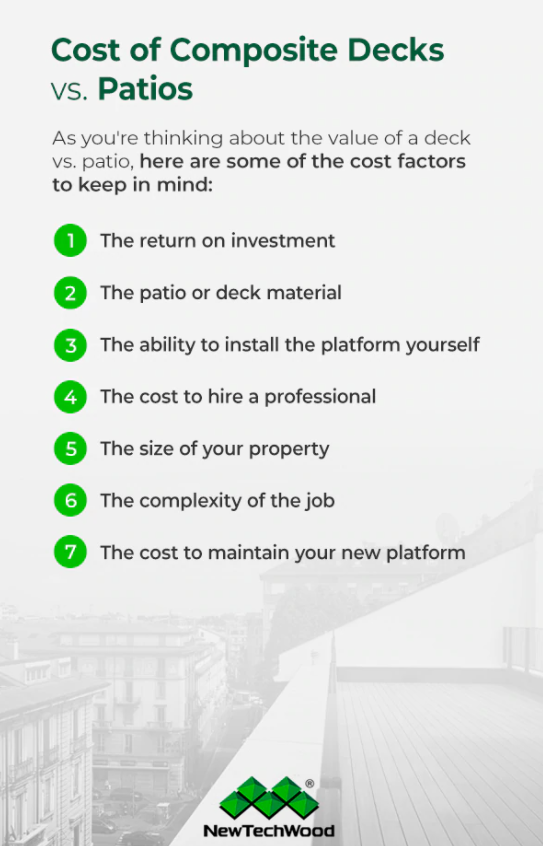
COST OF COMPOSITE DECKS VS. PATIOS
Installing an outdoor living area increases your property’s worth because it provides additional space to entertain your guests. As you’re thinking about the value of a deck vs. patio, here are some of the cost factors to keep in mind:
- The return on investment: Whether you want to sell your home in a few years or get it appraised for a higher rate, the money you pay for installing a new outdoor platform should increase your monetary property value. Composite wood decking provides a higher ROI than installing a patio, so it’s worth the additional upfront cost.
- The patio or deck material: The cost to install a patio or deck depends on the material you choose. Brick pavers may be more upscale, but stamped concrete is low-maintenance and more affordable. Even though composite wood decking costs more money upfront, it’s durable, aesthetically pleasing and easy to maintain, so you won’t have to pay a lot to take care of it.
- The ability to install the platform yourself: Both composite decking and patio pavers are easy to install, so you typically don’t have to pay a contractor to install them for you. Concrete patios can be heavy, but composite wood decking materials are so lightweight, you can install a new deck in no time. The composite decking installation process is also more straightforward than patio pavers, even if you don’t have any hardscaping experience.
- The cost to hire a professional: If you’re not comfortable installing the platform yourself, you might want to hire a professional. Composite wood decking tends to be more expensive to install than patio pavers when you have it done professionally.
- The size of your property: Hardscaping contractors typically charge you per square foot to lay down your composite wood decking or patio pavers, so you’ll have to pay more money if you want an expansive outdoor living area. You’ll also have to pay for more materials to cover the portion of the land.
- The complexity of the job: It seems that installing composite wood decking is more costly because you also have to include railings, stairs, fasteners and clips in your budget. However, paver patios may also be expensive to install if the ground on your property isn’t level. Creating an even surface for your patio can add a tremendous amount to your overall expenditure.
- The cost to maintain your new platform: Taking care of composite wood decking is more convenient and cost-effective than most paving materials. Unlike patio pavers, you don’t have to seal composite wood and pre-treat it to get it ready for winter. On the other hand, you’ll have to treat the soil underneath your bricks or concrete units so they stay even.
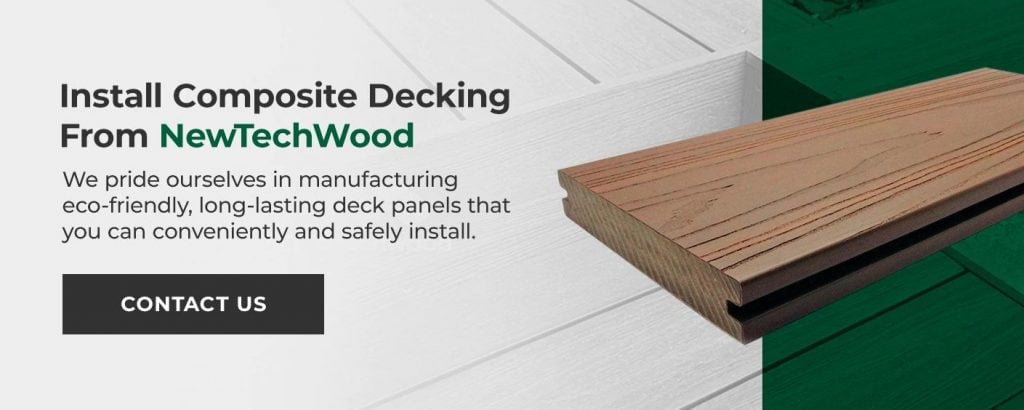
INSTALL COMPOSITE DECKING FROM NEWTECHWOOD
At NewTechWood, we supply high-quality composite wood deck materials to provide a functional space for your outdoor property. Whether you want to host your family over for summer parties or have a place to enjoy the pleasant view around you, our durable deck panels will give you a comfortable, low-maintenance area to relax for years to come. We pride ourselves in manufacturing eco-friendly, long-lasting deck panels that you can conveniently and safely install.
You can find our decking materials and tiles at most major home improvement stores. Enter your zip code to find a supplier near you, so you can start building your brand-new composite wood deck today. If you’d like more information about our products, you can call us toll-free at 1-866-728-5273.

